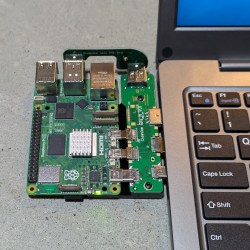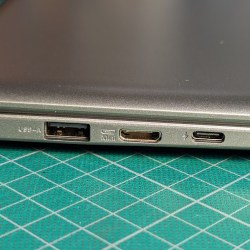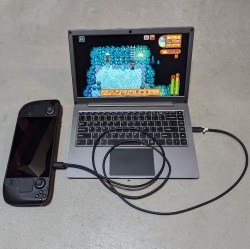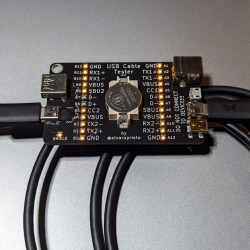A spare monitor and keyboard are handy things to have around, but they’re a bit of a hassle. They are useful for hardware development, plugging in to headless servers, or firing up a Raspberry Pi or similar single-board computer (SBC). If that’s something you do and portability and storage space are important to you, then you may be interested in the CrowView Note.
I got an opportunity to test and provide feedback on an early version of this unusual device, which is functionally a portable spare monitor plus keyboard (and touchpad) without the bulk and extra cables. Heck, it’s even giving me ideas as the guts of a Cyberdeck build. Let’s take a look.
What It Is
It really looks like a laptop, but it’s actually a 14″ 1920 x 1280 monitor and USB keyboard in a laptop form factor.
There is also an integrated trackpad, speakers and mic, and a rechargeable battery. That makes it capable of providing its own power, and it can even function as a power bank in a pinch. There’s an HDMI input on one side, and on the other is a full-featured USB-C port that accepts video input via the DisplayPort altmode.

The CrowView Note is a pretty useful device for a workbench where one is often plugging hardware in for development or testing, because there’s no need to manage a separate monitor, keyboard, and mouse.
It is not a laptop, but attaching an SBC like a Raspberry Pi makes it act like one. The three ports conveniently located on the left-hand side (HDMI in, USB-C out for power to the SBC, and USB-A in for peripherals like keyboard and trackpad) are all that are needed in this case. Elecrow offers a “cable eliminator” PCB adapters to make the process of connecting a Raspberry Pi 5 or a Jetson Nano as simple as possible. The result is something that looks and works just like a laptop.
Well, almost. The SBC will still be a separate piece of hardware, whether connected by cables or by one of Elecrow’s PCB adapters. The result is OK for bench work, but especially in the case of the PCB adapter, not particularly rugged. Still, it’s a nice option and makes working on such boards convenient and cable-free.
What It Isn’t
Visually the CrowView note looks so much like a laptop that it bears repeating: this is not a laptop. There are no processing brains whatsoever inside. It’s a portable and rechargeable monitor, keyboard, mic, and speakers in a laptop form factor.
Also, it is not a laptop kit. It’s got all the right hardware to act like one, but there’s no way to truly securely or semi-permanently attach an SBC. Attaching an SBC like a Raspberry Pi 5 can be done with cables or one of Elecrow’s PCB adapters, but the result is more a convenience than something that would survive being loaded into a bag or backpack and carried around.
Use Cases, and Video Input Options
A device like this is handy for any situation that would require a spare monitor and keyboard, like configuring headless systems or working with development kits. An HDMI and USB cable are all that’s really needed to provide monitor and keyboard/touchpad functionality in this way, and the built-in rechargeable battery means it can power itself as well as attached hardware.
The USB-C port on the left is a 5 V output for exactly this purpose, but the one on the right side is a full-featured port that supports modes such as power delivery (PD) and DisplayPort video over USB-C. Devices that support video in this way include some mobile phones, and portable devices like Valve’s Steam Deck (shown here.)
The only catch for video over USB-C is that both the device and the cable must support it. The DisplayPort altmode is one of USB-C’s high-speed interfaces and requires the cable to have the right pairs connected, or it won’t work. (Since cables all look the same from the outside, this is where a USB cable tester comes in handy.)
The Electrow Note is rechargeable, light, and charges and handles just like a laptop. It’s far less bulky than a standalone monitor and keyboard/mouse. This makes it attractive for use on a crowded workbench, or in field work where portability is key.
Limitations and Quirks
In my testing of an early version of the device, I found a couple quirks that are worth keeping in mind.
One is that this device is a monitor and keyboard/mouse all in one, and they aren’t really completely independent devices. That is to say, if the monitor isn’t getting a useable video signal, the display goes to sleep and seems to take the keyboard and touchpad functionality with it.
For example, pressing CAPS LOCK won’t toggle the caps lock indicator light because the keyboard isn’t “awake” without a video signal. I was unable to use the device just as a USB keyboard/mouse and ignore plugging in the monitor. Similarly, with no valid input video signal functions like brightness adjustment or using the monitor’s OSD menu are inaccessible. (Input switching and battery level display do work, however.)
Related to the above, the interface for adjusting monitor functions is basic, and understanding how it works may save time and frustration. As with many laptops, the function key row doubles as device controls with F1 for video input selection, F5 and F6 adjusting brightness down and up, and so on. On the version I tested, the default configuration is to have the function key row act as monitor controls. To send a literal F1 keypress from the keyboard, one must press Fn+F1. It’s possible to swap this behavior, but the setting reverts at the next power cycle, which led to some head-scratching on my part while troubleshooting.
The CrowView Note’s interface — while functional — isn’t completely obvious at first. On a workbench, one might be plugging a device like this into hardware that may not be working as it should, and its quirks can compound troubleshooting headaches unless one knows what to expect.
Does It Have a Place On Your Workbench, Or In Your Next Project?
Tabletop space and storage space are at premiums for most of us. The CrowView Note is an attractive all-in-one alternative to separate devices, especially with its rechargeable battery. That it includes speaker and mic and can work as a USB power bank in a pinch is a nice touch.
Honestly, it is also giving me DIY cyberdeck build ideas. Monitor, keyboard, speaker, mic, touchpad, and a 5000 mAh battery with charging circuitry built-in? It’s not a bad bundle of hardware for $169 USD. Elecrow is currently accepting pre-orders for the CrowView Note via a crowdfunding campaign if you’re interested.
How often do you find yourself needing to break out a monitor and keyboard, and what’s your favorite solution? Do you see a device like this as a space-saving tool, or more the basis of a hardware project like a cyberdeck build? Could you or have you DIYed something like this on the cheap? Let us know in the comments.



